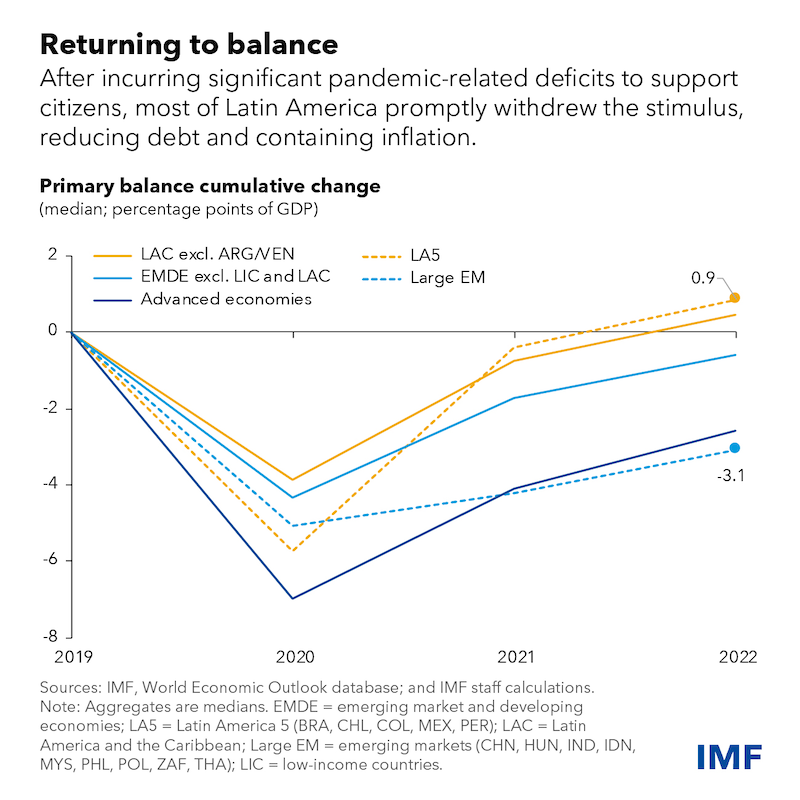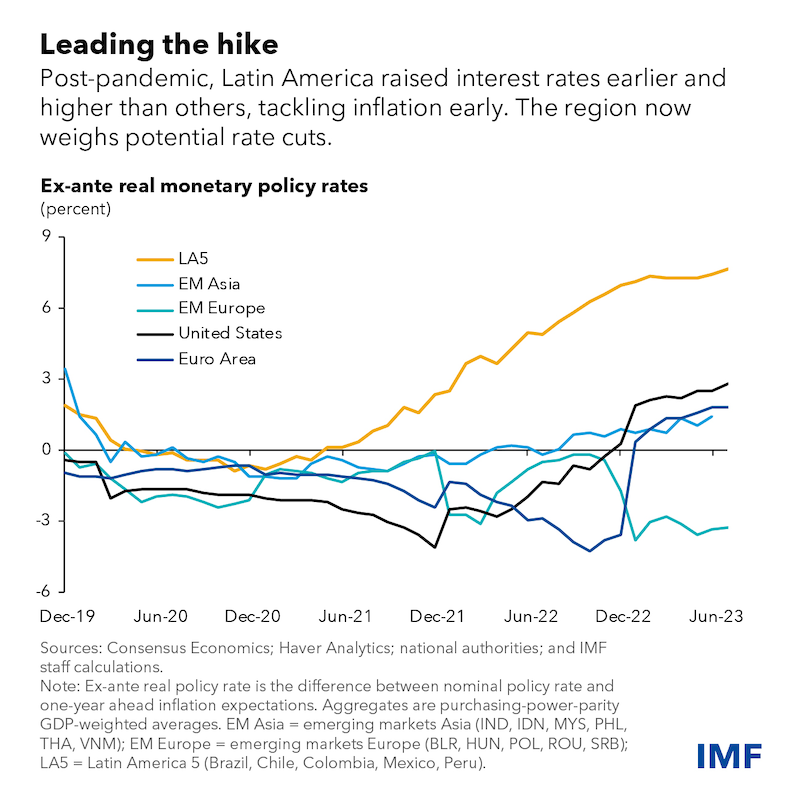“This time it wasn’t us,” Guillermo Ortiz, then governor of Mexico’s central bank, said at the 2008 start of the global financial crisis.
He spoke for emerging economies, accustomed to being at the epicenter of macroeconomic problems. Today, the sentiment holds even more true: most of Latin America not only remained resilient amid significant shocks over the past three years—including the pandemic, surging global inflation, trade tensions between large economies, and tighter global financial conditions—but they also responded appropriately from the perspective of their macroeconomic policies.
While large challenges persist, such as low economic growth and high debt levels, tackling them becomes more achievable when more countries in the region have robust and effective macroeconomic frameworks.
The IMF is here to assist, working with policymakers to sustain the momentum from their strong response to recent challenges. Our shared objective should be to foster economic growth that benefits all segments of society. This entails harnessing energy transition opportunities, further opening economies to global trade benefits, and strengthening existing safety nets to better protect citizens, among other priorities.
First to act
Like many others, Latin American countries incurred significant government budget deficits in 2020, reflecting a combination of increased spending and diminished revenues. These were exceptional times that needed a complementary response from loose monetary policy. It was critical to protect lives and livelihoods.
But unlike many of their global counterparts, most countries in the region withdrew the large fiscal expansion deployed during the pandemic in a timely manner.The primary fiscal deficit for the five major economies with inflation targeting and floating exchange rates—Brazil, Chile, Colombia, Mexico and Peru, known as LA5—rose by 6 percentage points of GDP in 2020, while the wider Latin American region saw an increase of 4 percentage points. That compares with a rise of 7 percentage points in advanced economies and just over 5 percentage points in emerging market economies in other regions.

The most notable divergence emerged in 2021 and 2022. While the LA5 countries, and indeed almost the entire region, completely withdrew this fiscal stimulus, achieving primary results surpassing pre-pandemic levels, advanced countries and other emerging economies maintained a significant part of the expansion, around 3 percentage points. This early withdrawal not only contributed to reducing public debt-to-GDP ratios but also helped contain inflation.
In fact, faced with the biggest inflationary surge since the adoption of inflation targeting, countries in the region acted with exceptional swiftness, raising interest rates earlier and to higher levels than other countries. Now, inflation is decreasing, currencies have appreciated in recent months, and the current discussion is about the pace of future interest rate cuts, which a few countries already started. This stands in contrast to other regions where deliberations still revolve around new hikes.
It’s also remarkable how medium-term inflation expectations were little changed in Latin America, underscoring the credibility of their inflation target frameworks, a phenomenon observed in several countries across the world. Moreover, the region did not suffer any significant financial stress, despite sharp exchange rate movements. This success can be attributed to improved financial regulation and supervision in the past two decades, significantly less fear of letting the exchange rate float, as well as the private sector’s ability to mitigate and manage risks from exchange rate exposure.

While acknowledging the differences among countries and the potential to achieve even greater macroeconomic stability, the transformative shift from a time when the region was beset by economic problems to its present state is both striking and encouraging.
The right policy components
This encompassing macroeconomic policy framework, which includes inflation targeting, central bank independence, exchange rate flexibility, fiscal rules aimed at ensuring fiscal sustainability while allowing deviations in extraordinary cases, and international financial integration, has expanded beyond the LA5 countries. Countries like Uruguay, the Dominican Republic, Paraguay, and Costa Rica have increasingly adopted this framework, with very positive results. We shouldn’t be surprised; this mirrors the approach to macroeconomics in successful small, open, advanced countries like New Zealand, Australia, Sweden, or Canada.
This approach to shaping macroeconomic policy is also potentially friendlier to the rest of the world than the alternatives, as it doesn’t inherently demand the accumulation of excessive international reserves and facilitates cross-country capital movements. However, there will always be unforeseen shocks that are usually more difficult for a developing region to absorb. That is why it’s necessary to remain vigilant and build or rebuild buffers, including through reserves or additional insurance mechanisms like the IMF’s precautionary credit lines.
Tackling remaining challenges
Of course, the recent macroeconomic management success does not mean an end to major challenges and difficulties.
Several economies are grappling with excessive public debt, and this challenge extends even to robust economies. This issue was present prior to the pandemic, with a worrisome upward trajectory, underscoring the need for continued efforts to ensure sustainability. The task becomes even more demanding amid less favorable external conditions.
More worrisome, other countries are confronted with significant risks arising from unsustainable macroeconomic policies. Addressing them is far from simple, especially when short-termism dominates.
Nevertheless, there are several countries that have had success in rebuilding macroeconomic frameworks, some of which received IMF support.
There are also deeper challenges demanding urgent attention in the entire region, including:
Enhancing long-term growth potential and overcoming stagnating productivity;
improving the persistently uneven distribution of income and power among citizens;
contributing to climate change mitigation and adapting to its effects;
curbing the proliferation of crime and reducing insecurity, a concern consistently at the top of citizen surveys; and
adapting to automation, robotization, and digitalization.Tackling these challenges starts with an orderly macroeconomic foundation. Given what several countries in the region have been able to achieve in recent years, we should have a renewed sense of hope and optimism for the future.
 Eurasia Press & News
Eurasia Press & News


